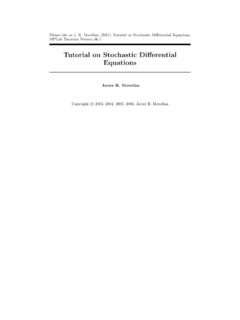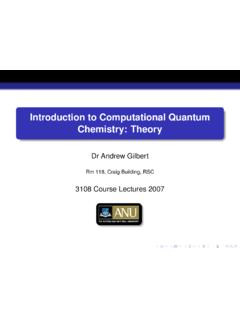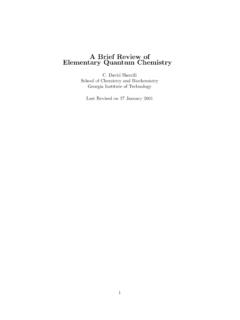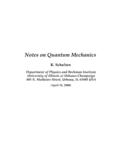Transcription of Simplest proof of Bell’s inequality - Lorenzo Maccone
1 Simplest proof of bell s inequality - LorenzoMacconeBell s theorem is a fundamental result in quantum mechanics: it discrim-inates between quantum mechanics and all theories where probabilities inmeasurement results arise from the ignorance of pre-existing local proper-ties. We give an extremely simple proof of bell s inequality : a single figuresuffices. This simplicity may be useful in the unending debate of what ex-actly the bell inequality means, since the hypothesis at the basis of the proofbecome extremely transparent. It is also a useful didactic tool, as the Bellinequality can be explained in a single intuitive IntroductionEinstein had a dream. He believed quantum mechanics was an incomplete de-scription of reality [1] and that its completion might explain the troublesomefundamental probabilities of quantum mechanics as emerging from some hid-den degrees of freedom: probabilities would arise because of our ignoranceof these hidden variables.
2 His dream was that probabilities in quantummechanics might turn out to have the same meaning as probabilities in clas-sical thermodynamics, where they refer to our ignorance of the microscopicdegrees of freedom ( the position and velocity of each gas molecule):he wrote, the statistical quantum theory would, within the framework offuture physics, take an approximately analogous position to the statisticalmechanics within the framework of classical mechanics [2].A decade after Einstein s death, John bell [3, 4] shattered this dream inthe worst possible way from Einstein s point of view [4]: any completion ofquantum mechanics with hidden variables would be incompatible with rela-tivistic causality!
3 The essence of bell s theorem is that quantum mechanicalprobabilities cannot arise from the ignorance oflocalpre-existing other words, if we want to assign pre-existing (but hidden) properties toexplain probabilities in quantum measurements, these properties must benon-local. This non-locality is of the worst possible kind: an agent with ac-cess to the non-local variables would be able to transmit information instantlyto a distant location, thus violating relativistic causality and awakening thenastiest temporal paradoxes [5].1 Modern formulations of quantum mechanics must incorporate bell s resultat their core: either they refuse the idea that measurements uncover pre-existing properties, or they must make use of non-local properties.
4 In thelatter case, they must also introduce some censorship mechanism to pre-vent the use of hidden variables to transmit information. An example of thefirst formulation is the conventional Copenhagen interpretation of quan-tum mechanics, which states that the properties arise from the interactionbetween the quantum system and the measurement apparatus, they are notpre-existing: unperformed experiments have no results [6]. An example ofthe second formulation is the de Broglie-Bohm interpretation of quantummechanics that assumes that particle trajectories are hidden variables (they exist independently of position measurements). bell s result is at the core of modern quantum mechanics, as it elucidates thetheory s precarious equilibrium with relativistic causality.
5 It has spawned animpressive amount of research. However, it is often ignored in basic quan-tum mechanics courses since traditional proofs of bell s theorem are rathercumbersome and often overburdened by philosophical considerations. Herewe give an extremely simple graphical proof of Mermin s version [7, 8] ofBell s theorem. The simplicity of the proof is key to clarifying all the the-orem s assumptions, the identification of which generated a large debate inthe literature ( see [9]).2 bell s theoremLet us define a local theory as a one where the outcomes of an experimenton a system are independent of the actions performed on a different systemwhich has no causal connection with the first. For example, the temperatureof this room is independent on whether I choose to wear purple socks s relativity provides a stringent condition for causal connections: iftwo events are outside their respective light cones, there cannot be any causalconnection among us define a counterfactual theory [10, 11] as one whose experimentsuncover properties that are pre-existing.
6 In other words, in a counterfactualtheory it is meaningful to assign a property to a system ( the positionof an electron) independently of whether the measurement of such property2is carried out. [Sometime this counterfactual definiteness property is alsocalled realism , but it is best to avoid such philosophically laden term toavoid misconceptions]. bell s theorem can be phrased as quantum mechanics cannot be both localand counterfactual . A logically equivalent way of stating it is quantummechanics is either non-local or non-counterfactual .To prove this theorem, bell provided an inequality (referring to correlationsof measurement results) that is satisfied by all localandcounterfactual the-ories.
7 He then showed that quantum mechanics violates this inequality , andhence cannot be local and experiments [12] performed to date have shown that bell inequalities areviolated, suggesting that our world cannot be both local and , it should be noted that no experiment up to now has been able totest bell inequalities rigorously, because additional assumptions are requiredto take care of experimental imperfections. These assumptions are all quitereasonable, so that only conspiratorial alternatives to quantum mechanics(where experimental imperfections are fine-tuned to the properties of the ob-jects [13]) have yet to be ruled out. In the next couple of years the definitiveBell inequality experiment will be performed: many research groups world-wide are actively pursuing we want to be extremely pedantic in enumerating the hypothesis at thebasis of bell s theorem, we must also request1.
8 That our choice of which experiment to perform is independent ofthe properties of the object to be measured (technically, freedom ofchoice or no super-determinism [4]): , if we decided to measurethe color of red objects only, we would falsely conclude that all objectsare red;2. that future outcomes of the experiment do not influence which appara-tus settings were previously chosen [14] (whereas clearly the apparatussettings will influence the outcomes): a trivial causality requirement(technically, measurement independence ).These two hypothesis are usually left implicit because science would be im-possible without proof of bell s theoremWe use the bell inequality proposed by Preskill [8], following Mermin s sug-gestion [7].
9 Suppose we have two identical objects, namely they have the sameproperties. Suppose also that these properties are predetermined (counter-factual definiteness) and not generated by their measurement, and that thedetermination of the properties of one object will not influence any propertyof the other object (locality).We will only need three propertiesA,B, andCthat can each take two values: 0 and 1 . For example, if the objects are coins, thenA=0 might meanthat the coin is gold andA=1 that the coin is copper (propertyA,material),B=0means the coin is shiny andB=1 it is dull (propertyB, texture), andC=0 means the coin is large andC=1 it is small (propertyC, size).Suppose I do not know the properties because the two coins are a gift intwo wrapped boxes: I only know the gift is two identical coins, but I do notknow whether they are two gold, shiny, small coins(A=0,B=0,C=1)ortwo copper, shiny, large coins(1,0,0)or two gold, dull, large coins(1,1,0),etc.
10 I do know that the properties exist (namely, they are counterfactualand predetermined even if I cannot see them directly) and they are local(namely, acting on one box will not change any property of the coin in theother box: the properties refer separately to each coin). These are quitereasonable assumptions for two coins! My ignorance of the properties is ex-pressed through probabilities that represent either my expectation of findinga property (Bayesian view), or the result of performing many repeated ex-periments with boxes and coins and averaging over some possibly hiddenvariable, typically indicated with the letter [4], that determines the prop-erty (frequentist view) [6]. For example, I might say the gift bearer will giveme two gold coins with a 20% probability (he is stingy, but not always).





